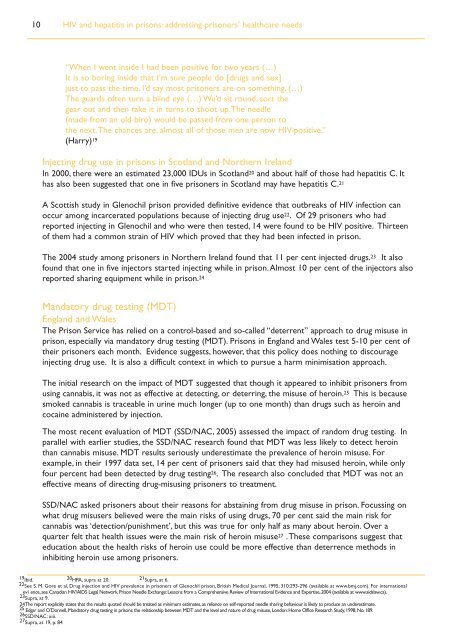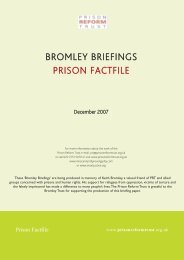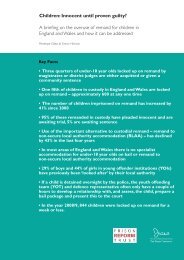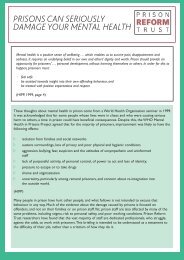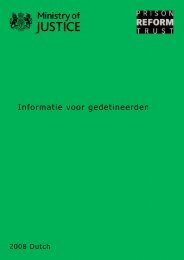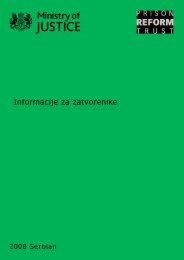HIV and Hepatitis in UK Prisons - Prison Reform Trust
HIV and Hepatitis in UK Prisons - Prison Reform Trust
HIV and Hepatitis in UK Prisons - Prison Reform Trust
Create successful ePaper yourself
Turn your PDF publications into a flip-book with our unique Google optimized e-Paper software.
10 <strong>HIV</strong> <strong>and</strong> hepatitis <strong>in</strong> prisons: address<strong>in</strong>g prisoners’ healthcare needs<br />
“When I went <strong>in</strong>side I had been positive for two years (…)<br />
It is so bor<strong>in</strong>g <strong>in</strong>side that I’m sure people do [drugs <strong>and</strong> sex]<br />
just to pass the time. I’d say most prisoners are on someth<strong>in</strong>g. (…)<br />
The guards often turn a bl<strong>in</strong>d eye (…) We’d sit round, sort the<br />
gear out <strong>and</strong> then take it <strong>in</strong> turns to shoot up.The needle<br />
(made from an old biro) would be passed from one person to<br />
the next.The chances are, almost all of those men are now <strong>HIV</strong>-positive.”<br />
(Harry) 19<br />
Inject<strong>in</strong>g drug use <strong>in</strong> prisons <strong>in</strong> Scotl<strong>and</strong> <strong>and</strong> Northern Irel<strong>and</strong><br />
In 2000, there were an estimated 23,000 IDUs <strong>in</strong> Scotl<strong>and</strong> 20 <strong>and</strong> about half of those had hepatitis C. It<br />
has also been suggested that one <strong>in</strong> five prisoners <strong>in</strong> Scotl<strong>and</strong> may have hepatitis C. 21<br />
A Scottish study <strong>in</strong> Glenochil prison provided def<strong>in</strong>itive evidence that outbreaks of <strong>HIV</strong> <strong>in</strong>fection can<br />
occur among <strong>in</strong>carcerated populations because of <strong>in</strong>ject<strong>in</strong>g drug use 22 . Of 29 prisoners who had<br />
reported <strong>in</strong>ject<strong>in</strong>g <strong>in</strong> Glenochil <strong>and</strong> who were then tested, 14 were found to be <strong>HIV</strong> positive. Thirteen<br />
of them had a common stra<strong>in</strong> of <strong>HIV</strong> which proved that they had been <strong>in</strong>fected <strong>in</strong> prison.<br />
The 2004 study among prisoners <strong>in</strong> Northern Irel<strong>and</strong> found that 11 per cent <strong>in</strong>jected drugs. 23 It also<br />
found that one <strong>in</strong> five <strong>in</strong>jectors started <strong>in</strong>ject<strong>in</strong>g while <strong>in</strong> prison.Almost 10 per cent of the <strong>in</strong>jectors also<br />
reported shar<strong>in</strong>g equipment while <strong>in</strong> prison. 24<br />
M<strong>and</strong>atory drug test<strong>in</strong>g (MDT)<br />
Engl<strong>and</strong> <strong>and</strong> Wales<br />
The <strong>Prison</strong> Service has relied on a control-based <strong>and</strong> so-called “deterrent” approach to drug misuse <strong>in</strong><br />
prison, especially via m<strong>and</strong>atory drug test<strong>in</strong>g (MDT). <strong><strong>Prison</strong>s</strong> <strong>in</strong> Engl<strong>and</strong> <strong>and</strong> Wales test 5-10 per cent of<br />
their prisoners each month. Evidence suggests, however, that this policy does noth<strong>in</strong>g to discourage<br />
<strong>in</strong>ject<strong>in</strong>g drug use. It is also a difficult context <strong>in</strong> which to pursue a harm m<strong>in</strong>imisation approach.<br />
The <strong>in</strong>itial research on the impact of MDT suggested that though it appeared to <strong>in</strong>hibit prisoners from<br />
us<strong>in</strong>g cannabis, it was not as effective at detect<strong>in</strong>g, or deterr<strong>in</strong>g, the misuse of hero<strong>in</strong>. 25 This is because<br />
smoked cannabis is traceable <strong>in</strong> ur<strong>in</strong>e much longer (up to one month) than drugs such as hero<strong>in</strong> <strong>and</strong><br />
coca<strong>in</strong>e adm<strong>in</strong>istered by <strong>in</strong>jection.<br />
The most recent evaluation of MDT (SSD/NAC, 2005) assessed the impact of r<strong>and</strong>om drug test<strong>in</strong>g. In<br />
parallel with earlier studies, the SSD/NAC research found that MDT was less likely to detect hero<strong>in</strong><br />
than cannabis misuse. MDT results seriously underestimate the prevalence of hero<strong>in</strong> misuse. For<br />
example, <strong>in</strong> their 1997 data set, 14 per cent of prisoners said that they had misused hero<strong>in</strong>, while only<br />
four percent had been detected by drug test<strong>in</strong>g 26 . The research also concluded that MDT was not an<br />
effective means of direct<strong>in</strong>g drug-misus<strong>in</strong>g prisoners to treatment.<br />
SSD/NAC asked prisoners about their reasons for absta<strong>in</strong><strong>in</strong>g from drug misuse <strong>in</strong> prison. Focuss<strong>in</strong>g on<br />
what drug misusers believed were the ma<strong>in</strong> risks of us<strong>in</strong>g drugs, 70 per cent said the ma<strong>in</strong> risk for<br />
cannabis was ‘detection/punishment’, but this was true for only half as many about hero<strong>in</strong>. Over a<br />
quarter felt that health issues were the ma<strong>in</strong> risk of hero<strong>in</strong> misuse 27 .These comparisons suggest that<br />
education about the health risks of hero<strong>in</strong> use could be more effective than deterrence methods <strong>in</strong><br />
<strong>in</strong>hibit<strong>in</strong>g hero<strong>in</strong> use among prisoners.<br />
19 Ibid. 20 HPA, supra at 20. 21 Supra, at 6.<br />
22 See S. M. Gore et al, Drug <strong>in</strong>jection <strong>and</strong> <strong>HIV</strong> prevalence <strong>in</strong> prisoners of Glenochil prison, British Medical Journal, 1995; 310:293-296 (available at www.bmj.com). For <strong>in</strong>ternational<br />
evi ence, see Canadian <strong>HIV</strong>/AIDS Legal Network, <strong>Prison</strong> Needle Exchange: Lessons from a Comprehensive Review of International Evidence <strong>and</strong> Expertise, 2004 (available at www.aidslaw.ca).<br />
23 Supra, at 9.<br />
24The report explicitly states that the results quoted should be treated as m<strong>in</strong>imum estimates, as reliance on self-reported needle shar<strong>in</strong>g behaviour is likely to produce an underestimate.<br />
25 Edgar <strong>and</strong> O’Donnell, M<strong>and</strong>atory drug test<strong>in</strong>g <strong>in</strong> prisons: the relationship between MDT <strong>and</strong> the level <strong>and</strong> nature of drug misuse, London: Home Office Research Study, 1998, No. 189.<br />
26 SSD/NAC: xiii.<br />
27 Supra, at 19, p. 84


